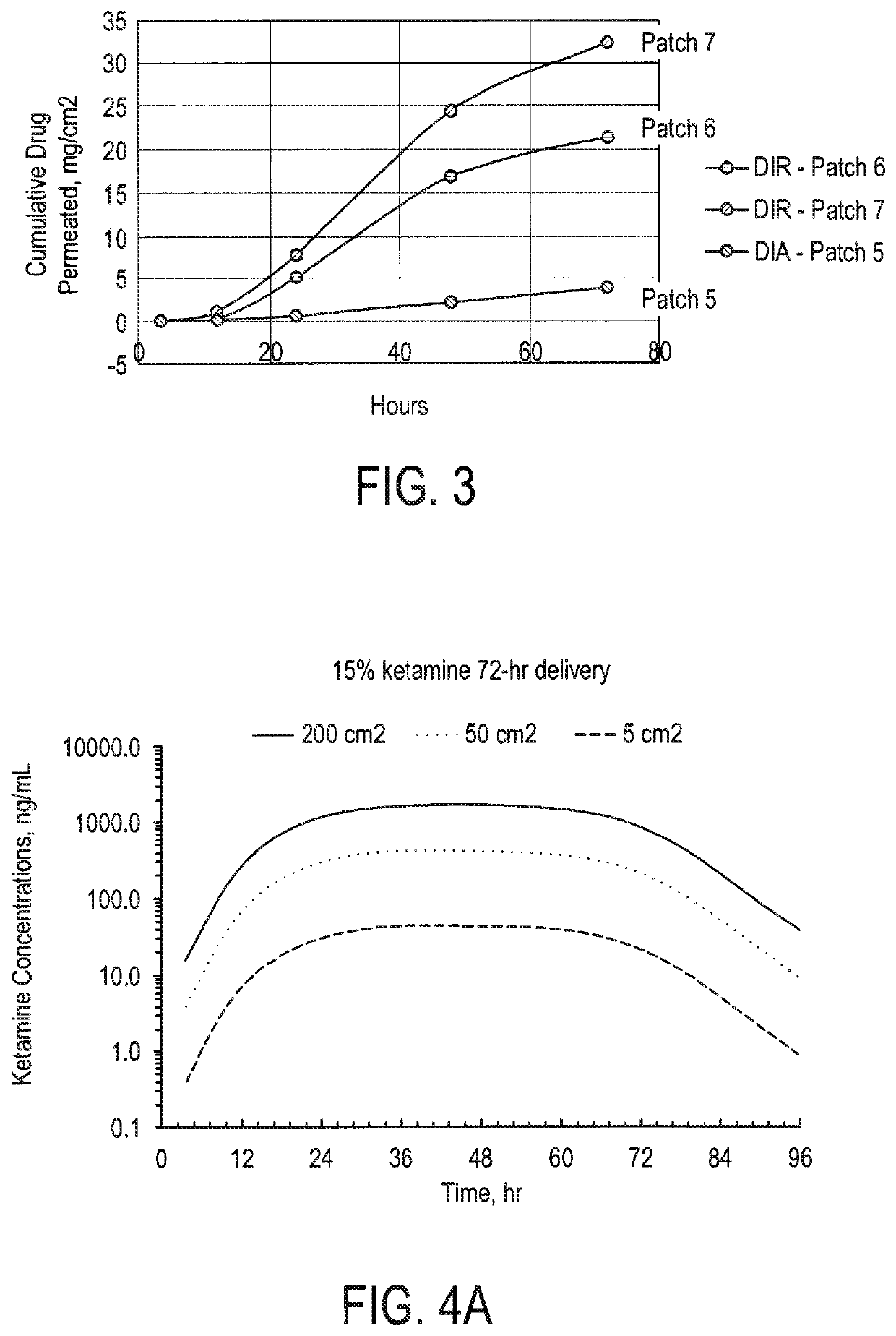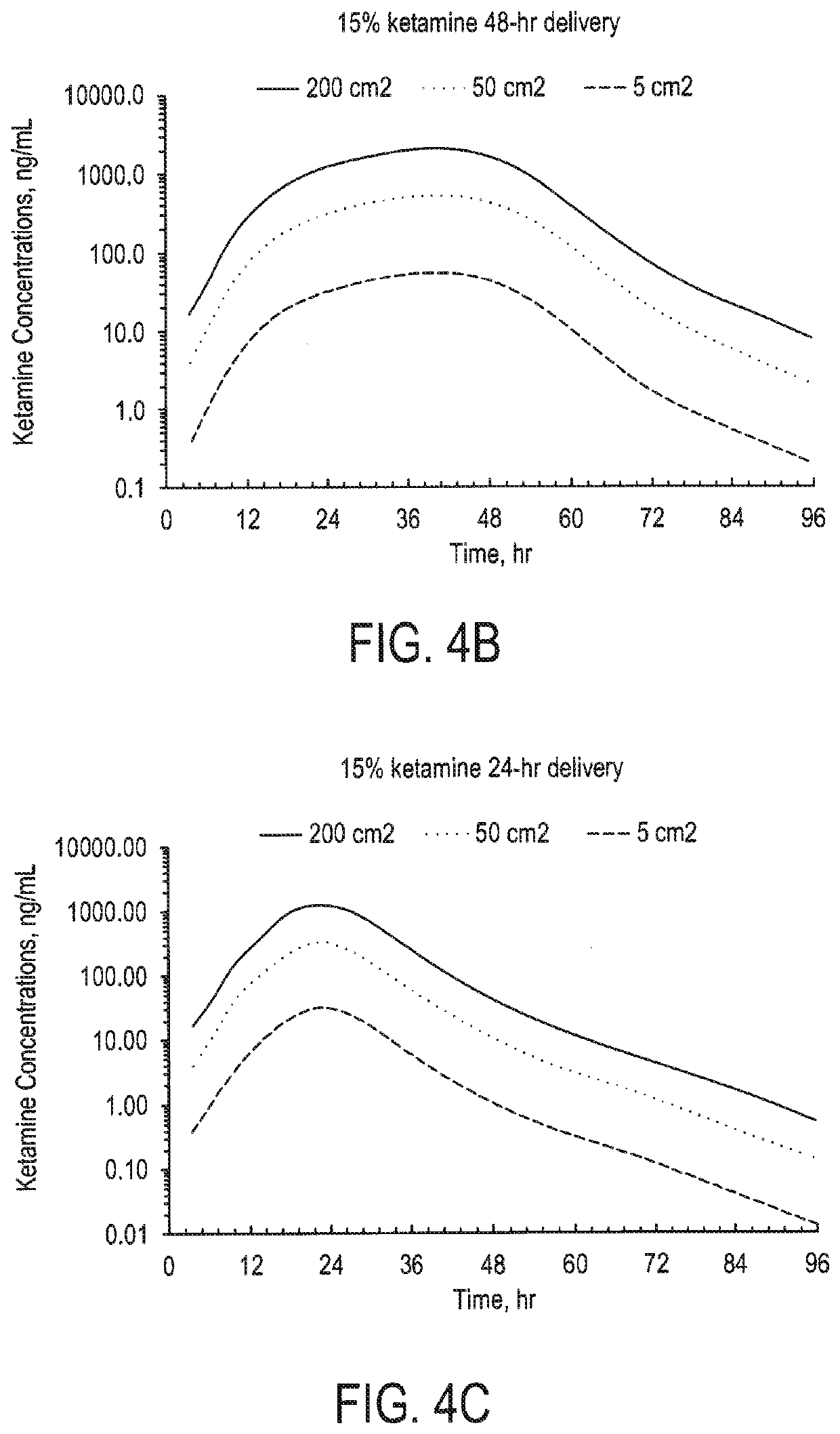Transdermal drug delivery system for ketamine
a technology of ketamine and transdermal delivery, which is applied in the direction of sheet delivery, medical preparations, organic active ingredients, etc., can solve the problems of insensitivity to such changes, and achieve the effects of reducing side effects, and enhancing the antidepressant
- Summary
- Abstract
- Description
- Claims
- Application Information
AI Technical Summary
Benefits of technology
Problems solved by technology
Method used
Image
Examples
example 1
Gel Formulation
[0293]The gel formulation was prepared by mixing (blending) the solvents, permeation enhancers, ketamine base, and the gelling agent listed in Table 4 below. The gel formulation can be used for preparing the ketamine DIR patches.
TABLE 4Composition of ketamine gelIngredientwt %wt %Ketamine base15% 10% Alcohol USP60% 67% Oleic alcohol5%5%Levulinic acid9%7%Propylene glycol9%9%Klucel HF (thickener)2%2%TOTAL100% 100%
example 2
DIR Patch—Preparation of Reservoir Patch Formulations
[0294]The reservoir patch devices include four main components: an impermeable backing, a drug reservoir which contains the drug dissolved in a gel vehicle, a microporous membrane, and an adhesive (FIG. 1). Reservoir transdermal patches are commercially available and the manufacturing methods well established. An exemplary process is shown in FIG. 2 and explained below.
[0295]A polypropylene membrane with 38% porosity (Celgard 2400) was used as the rate-controlling membrane. A heat-sealable polyester film (3M's 9730) was used as the backing layer. Pressure-sensitive adhesives were cast onto the release liner (e.g., No. 1022, 3M Company), and dried. A layer of Celgard 2400 was placed on top of the pressure-sensitive adhesive. The backing film was laid on top of the membrane, and heat sealing of the rim of a 1.77 cm2 circle proceeds using a die compressed for 10 seconds at 70° C. to form an empty pouch reservoir between the Celgard a...
example 3
Flux Studies
[0297]The reservoir patches (DIR, drug-in-reservoir) prepared were placed on the human cadaver skin preparation (commercially available, e.g., through New York Fire Fighters Skin Bank, New York, N.Y.), and then mounted in the Franz cell for the skin flux study. Skin permeation studies were performed for the patch formulations using Franz diffusion cells kept at 37° C. for the duration of the experiment. The receptor medium was phosphate buffered saline at pH 7.4, the receptor volume 12 ml and the permeation area 1.77 cm2. Human cadaver skin was used and all tests were performed in triplicate and the results below show the arithmetic mean value. The patch sample was placed at the donor site of the skin diffusion cells and the experiment was initiated with the receptor medium being continuously mixed. Samples of the receptor phase were obtained at 2, 4, 8, 12, 24, 48 and 72 h and ketamine concentrations were determined using HPLC method.
[0298]Patches 6 and 7 includes in th...
PUM
| Property | Measurement | Unit |
|---|---|---|
| time | aaaaa | aaaaa |
| time | aaaaa | aaaaa |
| time | aaaaa | aaaaa |
Abstract
Description
Claims
Application Information
 Login to View More
Login to View More - R&D
- Intellectual Property
- Life Sciences
- Materials
- Tech Scout
- Unparalleled Data Quality
- Higher Quality Content
- 60% Fewer Hallucinations
Browse by: Latest US Patents, China's latest patents, Technical Efficacy Thesaurus, Application Domain, Technology Topic, Popular Technical Reports.
© 2025 PatSnap. All rights reserved.Legal|Privacy policy|Modern Slavery Act Transparency Statement|Sitemap|About US| Contact US: help@patsnap.com



